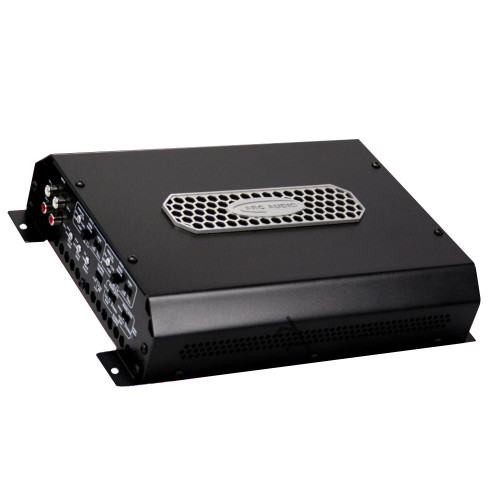Description
Arc Audio KS 300.4 V3 KAR Series Class G/H Amplifier
Class G and Class G/H amplifiers offer the best of all possible characteristics. Power output, distortion, efficiency, heat, noise, size are all class leading specs with this design. But why does this class of amplifier perform so well? It's built for music, not test tones or noise. When an amplifier is playing music, even at full volume, due to its dynamic nature, it is only working above 1/2 power about 10% of the time. You only need full power during the very loud passages like the impact of a drum or the pluck of a bass string. The rest of the time your 700-watt amp is making less than 350 watts. It's like having 2 amps in one. A 400-watt amp is much smaller and produces a lot less heat. Then, in a fraction of a second, your amp becomes an 800-watt monster that is ready for any musical challenge. The trick to making this work is in striking a balance between switching the high-power section on and off.
4-Channel Full Range Amplifier
Advanced Microprocessor Control System
Non-Digital Class G/H Switching Design
Code Based Flashing Diagnostics
Designed By Robert Zeff
Protection Against: Reverse Voltage, Over Voltage, Speaker Short, and Thermal Overload
Can Drive Highly Reactive Loads
Optically Isolated Mosfet Power Supply
Quiet Internal Fan Cooling
4-Channels @ 4 Ohms: 120 Watts
4-Channels @ 2 Ohms: 190 Watts
2-Channel @ 4 Ohms (Bridged): 380 Watts
Frequency Response: 5Hz - 50kHz
Crossover Range: 55Hz - 5500Hz
Bass Boost: 18dB @ 45Hz
S/N Ratio CEA2006 @ 1W: 95.2dB
S/N Ratio @ Full Power: 115.0dB
Input Sensitivity (Low): 200mV - 3.5V
Max Current Draw: 85A @ 800 Watts 1% THD
Idle Current: 1.14 Amp
Fuse: 3 x 30 Amp
Dimensions: 11.25(L) x 8.0"(W)x2.375"(H)
Class G and Class G/H amplifiers offer the best of all possible characteristics. Power output, distortion, efficiency, heat, noise, size are all class leading specs with this design. But why does this class of amplifier perform so well? It's built for music, not test tones or noise. When an amplifier is playing music, even at full volume, due to its dynamic nature, it is only working above 1/2 power about 10% of the time. You only need full power during the very loud passages like the impact of a drum or the pluck of a bass string. The rest of the time your 700-watt amp is making less than 350 watts. It's like having 2 amps in one. A 400-watt amp is much smaller and produces a lot less heat. Then, in a fraction of a second, your amp becomes an 800-watt monster that is ready for any musical challenge. The trick to making this work is in striking a balance between switching the high-power section on and off.
4-Channel Full Range Amplifier
Advanced Microprocessor Control System
Non-Digital Class G/H Switching Design
Code Based Flashing Diagnostics
Designed By Robert Zeff
Protection Against: Reverse Voltage, Over Voltage, Speaker Short, and Thermal Overload
Can Drive Highly Reactive Loads
Optically Isolated Mosfet Power Supply
Quiet Internal Fan Cooling
4-Channels @ 4 Ohms: 120 Watts
4-Channels @ 2 Ohms: 190 Watts
2-Channel @ 4 Ohms (Bridged): 380 Watts
Frequency Response: 5Hz - 50kHz
Crossover Range: 55Hz - 5500Hz
Bass Boost: 18dB @ 45Hz
S/N Ratio CEA2006 @ 1W: 95.2dB
S/N Ratio @ Full Power: 115.0dB
Input Sensitivity (Low): 200mV - 3.5V
Max Current Draw: 85A @ 800 Watts 1% THD
Idle Current: 1.14 Amp
Fuse: 3 x 30 Amp
Dimensions: 11.25(L) x 8.0"(W)x2.375"(H)





